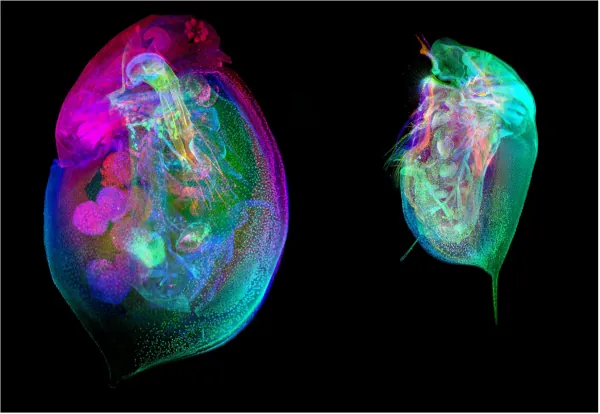
Breakthrough for Environmental Science: The First Daphnia Histology Reference Atlas is Here!
2025-01-10
Author: Yu
Introduction
A groundbreaking online resource focusing on **Daphnia**, a key indicator species for assessing environmental pollution, has been launched by a team of researchers at Penn State. Commonly referred to as the water flea, Daphnia is a small freshwater crustacean renowned for its remarkable sensitivity to pollutants, making it an invaluable asset in the study of toxicological effects of chemicals in diverse ecosystems.
Development of DaHRA
Until now, the impacts of chemicals were primarily assessed at the organismal level, but this innovative reference resource, named the **Daphnia Histology Reference Atlas (DaHRA)**, opens the door to a more in-depth analysis of **cellular and tissue-specific effects** of environmental toxins. Developed in collaboration with experts from the University of Birmingham in the UK and Mount Allison University in Canada, DaHRA represents the first dedicated atlas to enhance understanding of tissue responses to pollutants.
Importance of the Atlas
Dr. Khai C. Ang, assistant professor at Penn State's College of Medicine and the principal investigator of the project, emphasized that this atlas offers a valuable open-access tool for researchers. He explained, "It enables scientists to recognize the normal microanatomy of Daphnia, facilitating a more accurate interpretation of how environmental contaminants influence these organisms, which are vital for monitoring ecosystem health and sustainability."
Contents and Features of DaHRA
The creation of this comprehensive atlas involved meticulous efforts in tissue cutting, scanning, and labeling led by Dr. Mee Siing Ngu, who underscored the user-friendly design. The atlas features images of both male and female adult D. magna cut across three anatomical planes, which help in visually identifying specific organs and their developmental stages. Each tissue plane is color-coded and presented from various angles, ensuring that users can easily navigate and interpret the data presented.
User Engagement and Collaboration
The online platform boasts seamless navigation capabilities, allowing users to zoom in on high-resolution images and access standardized anatomical labels, further democratizing scientific knowledge. This user engagement is crucial for fostering collaboration and information exchange among scientists, educators, and policymakers striving toward better environmental conservation practices.
Contributions from Experts
The atlas project was pioneered by Dr. Keith Cheng, a distinguished professor at the College of Medicine, who highlighted the importance of understanding normal tissue morphology. He noted that recognizing the underlying normal structures is essential for diagnosing both human diseases and environmental impacts, particularly in toxicology.
Professor Dr. Luisa Orsini from the University of Birmingham added, “The DaHRA shows how harmful substances can affect specific tissues long before resulting in developmental failure or mortality. By combining histological data with advanced molecular techniques, we have the potential to significantly enhance our ability to evaluate chemical risks, ultimately improving environmental protection and regulations.”
Future Directions
The introduction of DaHRA not only redefines ecotoxicological research but also has profound implications for environmental sciences at large. Looking ahead, Dr. Ang and his team aim to integrate the findings from DaHRA with molecular toxicology data, enhancing the understanding of how various chemicals adversely affect organisms. Moreover, they plan to adapt the methodologies employed in the Daphnia atlas for application in studying other model organisms, further broadening the impact of this pioneering work.
Conclusion
As environmental challenges grow increasingly complex, initiatives like the Daphnia Histology Reference Atlas provide a beacon of hope, empowering scientists with tools that can improve our understanding and management of ecological health. This resource is set to alter the landscape of environmental research, inviting all stakeholders to engage and participate in ensuring a sustainable future.


 Brasil (PT)
Brasil (PT)
 Canada (EN)
Canada (EN)
 Chile (ES)
Chile (ES)
 Česko (CS)
Česko (CS)
 대한민국 (KO)
대한민국 (KO)
 España (ES)
España (ES)
 France (FR)
France (FR)
 Hong Kong (EN)
Hong Kong (EN)
 Italia (IT)
Italia (IT)
 日本 (JA)
日本 (JA)
 Magyarország (HU)
Magyarország (HU)
 Norge (NO)
Norge (NO)
 Polska (PL)
Polska (PL)
 Schweiz (DE)
Schweiz (DE)
 Singapore (EN)
Singapore (EN)
 Sverige (SV)
Sverige (SV)
 Suomi (FI)
Suomi (FI)
 Türkiye (TR)
Türkiye (TR)
 الإمارات العربية المتحدة (AR)
الإمارات العربية المتحدة (AR)